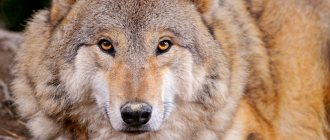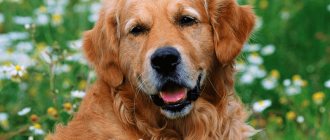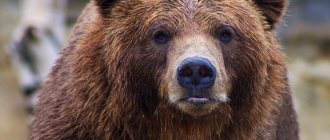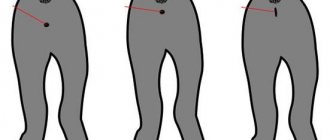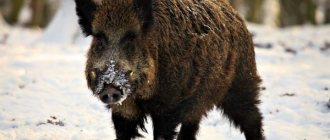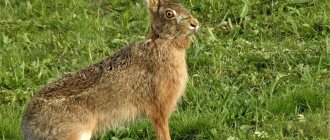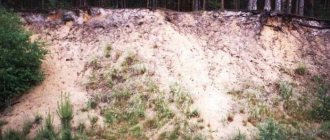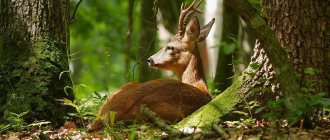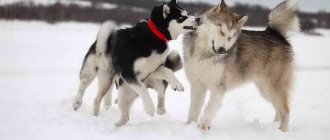- October 27, 2018
- Hunting
- Barinova Vera
Two related species of animals, so different from each other, can confuse an inexperienced tracker. Even those who encounter these animals every day do not know how wolf tracks and dog tracks differ from each other in the snow. Only observation and careful attention to detail allow the hunter to identify significant differences. Meanwhile, there are quite a lot of them. What do you need to know about footprints in general, and wolf prints in particular? What do changes in the nature of tracks indicate? How are the structural features of a wolf or dog reflected in their prints in the snow?
General information about wolves
The wolf is an incredibly powerful animal, with a gray coloration and a dark saddle-shaped spot on its back. Its head is large, and its body length often exceeds 100–130 cm. The largest representatives of the species are found in Central Russia, in the North, where the weight of the animal reaches 80 kg, and in other cases it ranges from 35 to 60 kg. Desert wolves are much smaller than northern wolves.
This predator searches for food in open areas and is found in river valleys and in quiet places near the shore. The most common prey a wild animal gets is carrion, ungulates, birds and rodents. This is why wolf tracks can often be found near pastures.
Wolves are widespread in Russia, although they will not come closer than 60–80 km to a big city. They are nocturnal animals, living in a pack of 6 to 10 family members. The latter are classified as follows:
- Profits - less than a year, approximately 5-7 heads.
- Pereyarki - from one year old, last year's brood. By July they begin to howl in hunting areas and dens.
- Seasoned - more than two years. From April to October they live sedentary, raising broods.
- Old - more than five years old, with broken teeth and unable to hunt.
Wandering from place to place, predators leave many prints in the snow that look like those of a dog.
Area
The wolf is the most common land predator. Historically, the range occupied by the wolf was second in area after the range of humans. Nowadays, the wolf's range and its total number have decreased significantly, the main reason for this being human activity: changes in the natural environment, urban development and the extermination of wolves as a result of hunting them.
In many regions of the world, the wolf is on the verge of complete extinction, but in the north of Eurasia and America there are still many wolves.
In Europe, the wolf is found in Spain, Portugal, Italy, the Baltic countries, Russia, Belarus, Poland, the Scandinavian countries, the Balkans, and Ukraine.
In Asia, wolves live in Korea, parts of the territories of China and India, the Caucasus, Kazakhstan, Kyrgyzstan, Afghanistan, Iran, Iraq, and the north of the Arabian Peninsula.
Throughout North America, from Alaska to Mexico. In Africa, wolves are found in Ethiopia. In South America: Brazil, Bolivia, Paraguay.
In terms of numbers, the most wolves are in Russia - 70 thousand, in Canada and Alaska 50 thousand, in the United States 6500 wolves, in Spain 2000 wolves, in Poland 700 wolves, in Italy 300 wolves, in Norway and Sweden about 80.
Features of the view
Despite the fact that the wolf is a cautious animal, its favorite places are almost the entire landscape, where open territory predominates. Traces of a wolf can be found in the steppe, forest-steppe, deserts, and sparse forests. The life of a male takes place next to a she-wolf, who is his permanent mate. Near their lair there are always many wolf prints, and the smell of the decaying remains of victims is mixed with the spirit of the owners of the home themselves.
A she-wolf's pregnancy lasts about 65 days, after which traces of wolf cubs appear near the den. Despite the created family, it is difficult to even catch a glimpse of a pair of wolves - they notice danger long before it appears on the horizon, and manage to hide or move to another place. Therefore, a hunter can, for a long time, without seeing a live wolf, encounter its tracks in the snow, wet ground, or sand. Let's look at how dog and wolf prints differ in size, character and location on the ground.
Large stray dogs
It is with them that wolves can most often be confused - approximately the same body constitution, life in packs and in characteristic habitats makes domestic animals similar to their wild brothers. But stray dogs are much smaller than a wolf, which is why wolf tracks can be recognized by their size: if the paw is large, then it is unlikely to be a dog.
It is also worth paying attention to the area where paw prints were found; for example, in a dense forest they will belong to a seasoned animal. And in the reeds near the shore or field - a dog, which, as a rule, does not run away from the house more than 10 km.
Common features
The wolf and the dog belong to the family of mammals that feed their offspring with milk and have a number of other common characteristics:
- They are natural predators, regardless of what owners feed their pets.
- They have a similar appearance (applies to some breeds of pets).
- They are sociable animals if they are in their environment.
- They are capable of making similar sounds (howl, growl, bark) due to the similar structure of the vocal cords, but they use them in completely different situations.
But despite some common features, these animals have many differences.
Let's look at the difference between the tracks of a wolf and a dog, in the photo
Wild animals do not spread their fingers like their counterparts, so their tracks always look more collected or “slender.” Thus, the paw print of a large dog and a small wolf in the snow will still be different: a small but collected footprint will not allow it to be confused with a large and wide wolf print. The pet initially holds its paw as if in a fist and gently advances. By lowering its paw onto its toes, the dog does not spread them out, since it does not need to increase the area of support.
We will further understand the difference between a dog's track and a wolf's. If you number the wolf claws from 1 to 4, you can see that they are located in pairs: the first and fourth are on the same level and you can draw a straight line from their claws. And the second and third are set slightly forward, while their beginning will lie on the line of the claws of the first pair. Between the second, you can also mentally draw a straight line parallel to the first. This will not work for a dog - all its fingers are located in a semicircle and at the same distance from each other.
How to draw dog or wolf eyes.
First, let's draw an oval.
We draw the outlines of the eyelids.
Now the corners of the eyes.
Draw the pupil. Remember that its size directly depends on the lighting.
Easily draw the surroundings of the eye. These are, one might say, eyelids and eyebrows.
Step 6.
To create depth, add shadows under the upper eyelid (it points forward), both in the light part of the design and in the eye itself.
Step 7
To draw an eye in profile, start the drawing not with an oval, but with a drop. The rest is basically the same.
Now you know how to draw a wolf's eye. The main difference between the eyes of wolves and dogs is that the edges of the eyelids of wolves are not as dark as those of dogs, and also that the eyes of a wolf are slightly rounder (so that the eyeball is visible). The most common eye color for dogs is brown, while wolves usually have amber or yellow eyes (but never blue!).
Print distance
The impression of dog and wolf tracks is also influenced by the manner of walking and the pads of the fingers. In a domestic animal, they are less convex, which is why the wolf's paws leave more prominent prints in the snow. A wild animal transfers the weight of its body to its front paws, which is why they leave a deeper and larger footprint than their hind paws. The dog carries its body weight relatively evenly, and therefore there is no such difference between the front and hind limbs. Due to the size of the tracks, you can notice other features that are not visible at first glance: gender, age, special features.
Thus, an experienced hunter who knows the inhabitants of a given area and understands tracks can track a particular wolf for a long time by the way it places its paws, what scars it has on its fingertips, claws and favorite places. Two wolves cannot have absolutely identical limb prints, just like people’s palms. However, differences will be observed in other aspects as well.
The tracks will tell you a lot
You can find out whether a male or a female has recently walked through the snow by their size: if the length of the first track is 1.3 times greater than the width, then the female’s is 1.5 times greater. The she-wolf has smaller footprints, which are also slightly longer compared to the prints of a male of the same age. In addition, urine on the snow gives a clue about gender: while a wolf tends to urinate on vertical objects, the she-wolf leaves a neat horizontal puddle.
Wolf tracks will also tell you a lot about the age of the animal:
- Profits - 8.5 cm in length.
- Pereyarki - 9.3 cm in length.
- Old ones - 10.5 cm in length.
There are tracks 14 cm in length, but these are average figures for a Central Russian wolf. Naturally, females have tracks slightly smaller than males and the numbers then decrease by several mm. Saint Bernards, Great Danes and Caucasian Shepherds leave tracks larger than 12 cm, however, if this is not their territory for walking, then the tracks are unlikely to belong to dogs.
General information
For many, animal tracks are just paw prints or paths trodden by forest inhabitants, but for professional hunters, this is everything that the animal left on a certain section of its route. It could be a broken or eaten branch, nut shells, or the remains of prey. Here you can see droppings, which is also a kind of trace.
To detect burrows and nests of animals, bird nests, the hunter tries to obtain as much information as possible. Therefore, even a feather lost by a wild duck or hazel grouse or a piece of fur caught in a bush can tell an experienced tracker a lot.
Wild animals have excellent sense of smell, hearing and vision and also behave very carefully. Having noticed a person, they may not run away or fly away, but simply hide and wait
Therefore, the main key to unraveling the mysteries of the life of animals is, first of all, their traces.
Knowing and studying the tracks of wild animals, birds, insects and reptiles will make it possible not only to find out who you are dealing with, but also how old the track is and the direction of movement of the animal. All this together allows you to hunt effectively without being distracted by the animal’s old footprints, and also to eliminate unnecessary encounters with a predator. Skillful reading of animal prints significantly reduces hunting time. It’s good to have an experienced tracker when studying them, but even without one, with perseverance, you can achieve positive results.
Precise prints are clearly visible on wet, freshly fallen snow no more than 5 cm thick. At this time, you can familiarize yourself with the tracks using the example of domestic animals - cats, dogs, pigs, goats, cows, ducks, etc. There are features that need to be kept in mind:
- The tracks of a large dog are very similar to those of a wolf.
- Felines are similar to larger prints of their wild counterparts: jungle cat, lynx, leopard, tiger.
- The markings of a pigeon's paws are similar to those of a partridge.
- The tracks of a cow are similar to the outlines of the hooves of an elk, a large wild boar, etc.
What else is the difference between the tracks of a wolf and a dog?
It is interesting that the nature of the tracks depends on what gait a representative of one of the species was moving at the moment. For example, a step is a slow chain that can stretch over long distances. With this gait, a wolf goes to rest after a successful hunt and a hearty dinner. The length of the steps is usually about 25 cm, and the chain is less even than if he were trotting or trotting.
A dog is another matter: it can also walk for quite a long time over long distances, but the trajectory is rarely smooth, and the chain of tracks turns out to be winding. In addition, the dog moves faster from walking to running and vice versa.
The wolf moves most often at a trot, and therefore such tracks are the most common. In this case, the hind paws fall exactly into the front paws, forming a chain of uniform tracks of the front paws. The hind limb may not exactly match the imprint of the front one, then it is duplicated and it becomes finally clear that the wolf was moving at a trot. This is a way to hide from danger, and thus a wild animal can travel 70 km in a night.
Contact with a person
Wolves very rarely attack people; some kind of emergency is needed. For example, a lonely male who was kicked out of the pack. He attacks from hunger.
A pack of animals prefers to find wounded, sick or young animals. Man is too dangerous for predators.
Wolves can control a large area - several hundred meters. Other wolves are warned of the conquered territory by a chorus howl. If there are few animals in the area where predators live (during cold winter or drought), then the entire population can be destroyed.
Then the flock moves to a new place. If there is enough prey, the wolf population increases rapidly.
Location of traces
Let's look at the photo, at the trail of a wolf running through the quarry. It can be easily distinguished from other gaits: the hind legs are lifted slightly ahead of the front ones, which is why the hind and front legs stand in pairs, forming a gap between them. This is most typical for dogs, and therefore it is difficult to distinguish a domestic animal from a wild animal using such tracks. The trail can be determined after the individual moves to a slower pace - wolves catch nearby prey, thus this chain will change to another, more characteristic one.
Animal physiology also influences the difference between tracks. In dogs, there is approximately the same distance between the two front and hind limbs, while there is a more visible gap between the front and rear pairs. That is, the dog never runs in a straight path, it meanders. Because her limbs are located on the sides of the chest. In a wolf, all four paw prints are evenly spaced from each other because its limbs are located exactly under the ribcage, regardless of its width. Therefore, his prints, like those of a fox, are on the same line, while those of a domestic animal are to the left and right of the line.
Animal differences
First of all, it is worth noting the obvious difference: the wolf is a wild animal, and the dog is domesticated by man, which is distinguished by the diversity of species and significant differences in appearance, which sometimes make them completely different from representatives of the same canine family. But even those breeds that really look like their wild relatives have a number of characteristic features, knowing which you can easily distinguish one animal from another.
The differences between a wolf and a dog are manifested in the following parameters:
- Dimensions. As a rule, wolves are larger in size. Their average weight ranges from 34-55 kg, but sometimes males can gain up to 80 kg of mass.
- Head shape and muzzle. The wolf's head is shaped like the head of the German Shepherd breed, but it is more massive and has a more elongated and pointed muzzle.
- Ears. Wolves are simply not able to press them to their heads, so they always keep them raised. The ears are usually small in size relative to other parts of the body and are overgrown with hair on both the outer and inner surfaces.
- Tail. In wild predators, the tail never curls, is held horizontally to the ground or lowered down and always remains practically motionless. Only pets are characterized by wagging their tail to express emotions.
- Jaws. Representatives of wolves have a fairly narrow jaw, which is characterized by greater strength.
- Eating. Wild predators always eat very slowly because they may choke.
On a note! The characteristic groans and whines during a meal are associated precisely with the rapid swallowing of food, as a result of which wolves experience pain.
- Movement style. The wild predator moves at a trot, and its hind legs are placed exactly in the already imprinted tracks of the forelimbs. When moving in groups, they follow each other in the tracks of the first animal in the pack, which makes it easier to move long distances.
- Movement speed. Although predators can stalk prey for days, they cannot sustain high-speed pursuit over long distances (more than 300 m).
- Attitude towards prey. During a hunt or fight, a dog immediately bites the victim to death, while a wolf seems to cut it into pieces, which is due to the anatomical features of the structure of the jaws.
Let's look into the issue further
The tracks of a wolf can change their character if it is a pack. It is interesting that wild animals walking behind try to follow those in front. Because of this, it becomes difficult to figure out whether one wolf or the whole pack was moving here. This method of movement makes it easier to cover distances along a deep trail and has the additional advantage of confusing enemies. But there are several differences:
- The protruding lower one is clearly visible from the top print.
- The tracks are deeper.
- There may be places where the prints move away and then come back together: tired wolves change places.
For dogs, this behavior is unnatural and the described tracks can definitely be considered wolf marks. A string of prints, their straightness, depth, distance between the paws can tell a lot about the animal, and therefore the tracker skill is very useful for the hunter.

